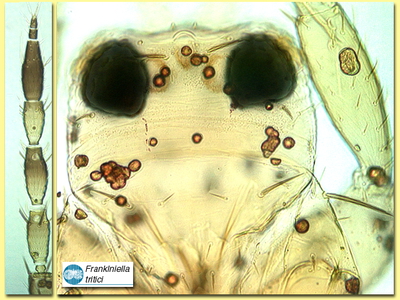Figures
Fig. 1 Antenna and head
Fig. 2 Pronotum
Fig. 3 Fore and hind wing
Fig. 4 Tergite VIII and IX (female)
Species
Frankliniella tritici Fitch
Biology
Known as the Eastern Flower Thrips in North America, this species is a pest of several fruit crops including raspberries and strawberries, field crops such as cotton and beans, and also flower crops especially roses. Contrary to its name, it is not associated with cereal crops.
Distribution
Widespread in North America, also recorded from Mexico and Argentina.
Recognition
Body and legs yellow, tergites variably shading medially, major setae dark; antennal segment I white, II dark at apex, III lightly shaded at apex, IV brown in distal half, V yellow, VI-VIII brown; forewings pale. Head as wide as long, with transverse lines of sculpture on vertex; 3 pairs of ocellar setae present, III on anterior margins of ocellar triangle; major pair of postocular setae shorter than ocellar setae III. Antennae 8-segmented, III & IV with sense cone forked; pedicel of III medially sharply angulate. Pronotum with 2 pairs of long setae on anterior margin, median pair shorter than lateral pair, 2 pairs of long posteroangulars, and one pair of long posteromedial setae. Metanotum with median setae arising at anterior margin. Forewing with both longitudinal veins bearing complete row of setae. Tergites V-VIII each with a ctenidium laterally, on VIII anterolateral to spiracle; tergite VIII posterior margin with a comb of slender microtrichia laterally but not medially. Sternites with no discal setae. Male sternites III-VII with transversely oval glandular area.
Related species
Amongst the 160 species of this genus, a similar swollen and angulate pedicel to the third antennal segment is found only in a few species from Central and South America.





